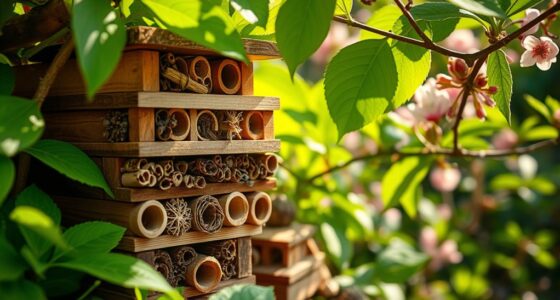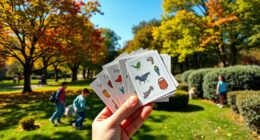Creating nature scavenger hunts with built-in vocabulary lists offers a fun way to make outdoor exploration educational and engaging for kids or clients. These activities encourage spotting local plants, wildlife signs, and ecosystems while building environmental literacy. By focusing on observation and identification skills, you help boost awareness of nature’s diversity. Keep exploring to discover how you can design effective hunts that foster curiosity, learning, and conservation efforts in your community.
Key Takeaways
- Integrate vocabulary lists of local flora and fauna to enhance learning during scavenger hunts.
- Offer customizable kits with pre-made vocabulary cards for educational and business use.
- Use vocabulary-based scavenger hunts to promote environmental awareness and team-building activities.
- Develop curricula or programs that combine wildlife tracking, plant identification, and vocabulary learning.
- Create branded or themed scavenger hunts for schools, nature centers, or corporate team events to boost engagement.
A nature scavenger hunt is a fun and engaging way to explore the outdoors and connect with the environment around you. When you set out with a list of items to find, you’re not just wandering aimlessly—you’re actively observing, learning, and discovering the world in a new way. Incorporating wildlife tracking and plant identification into your hunt adds depth to the experience, making it both educational and exciting. As you search for different species and signs of animal activity, you’ll develop a keen eye for detail and a better understanding of local ecosystems.
Wildlife tracking is one of the most thrilling aspects of a nature scavenger hunt. Instead of simply spotting animals, you learn to read the signs they leave behind—tracks, droppings, or even chewed plants. You might notice a series of small paw prints in the mud, indicating the recent passage of a fox or raccoon. Recognizing these clues helps you piece together the story of what’s been happening in the area. It’s a skill that sharpens your observation and patience, making each discovery more rewarding. Plus, wildlife tracking encourages you to move quietly and observe carefully, increasing your chances of spotting animals in their natural habitat.
Plant identification is equally mesmerizing. As you search for various flora, you learn to differentiate between trees, shrubs, and flowering plants by their leaves, bark, and overall shape. Having a built-in vocabulary list of plant names helps you memorize key features and quickly identify new specimens. For example, you might recognize a plant with broad, serrated leaves as a type of wild blackberry or notice the distinctive flowers of a native wildflower. This knowledge turns a simple walk into a botanical lesson, and it’s incredibly satisfying to name the plants you encounter. Over time, you’ll become more confident in your ability to identify native species, which enhances your appreciation for local biodiversity and encourages conservation.
Frequently Asked Questions
How Can I Adapt Scavenger Hunts for Different Age Groups?
You can adapt scavenger hunts for different age groups by tailoring the challenges to be age appropriate. For younger kids, keep tasks simple and visual, while older participants enjoy more complex or riddling clues. Customize the difficulty level by adding or removing steps, and incorporate themes or educational elements. This way, everyone stays engaged and challenged, ensuring a fun and rewarding experience regardless of age.
What Safety Precautions Should I Consider During Outdoor Hunts?
When planning outdoor hunts, you should prioritize safety by teaching wildlife awareness so participants recognize potential hazards. Always check the weather forecast and prepare for sudden changes, bringing essentials like water, sunscreen, and appropriate clothing. *Guarantee* the area is safe, free of dangerous plants or animals, and set clear boundaries. Keep a first aid kit handy, and supervise children closely to prevent accidents, making the experience enjoyable and safe for everyone.
How Do I Incorporate Technology Into Nature Scavenger Hunts?
Like explorers venturing into new worlds, you can incorporate technology into your scavenger hunts by using augmented reality to bring items to life and digital mapping to guide participants. These tools create immersive experiences, making the hunt more engaging and educational. You can also set challenges that require scanning QR codes or using GPS to find hidden clues, blending adventure with innovation. This modern approach enhances fun and learning simultaneously.
Can Scavenger Hunts Be Used for Educational Purposes Beyond Vocabulary?
You can definitely use scavenger hunts for educational purposes beyond vocabulary. They serve as engaging team building activities and encourage sensory exploration by prompting participants to observe, touch, and smell their environment. Incorporate clues related to science, history, or math to deepen learning. This hands-on approach boosts collaboration, critical thinking, and curiosity, making the experience both fun and educational for all ages.
What Are Some Eco-Friendly Tips for Organizing These Hunts?
To make your scavenger hunt eco-friendly, start by using eco-friendly materials like biodegradable paper for clues and reusable containers for supplies. Incorporate recycling tips by encouraging participants to sort trash properly and reuse items when possible. Choose natural locations to reduce travel emissions, and remind everyone to leave no trace. This way, you promote environmental awareness while organizing fun, sustainable activities for all ages.
Conclusion
Now that you’ve explored nature scavenger hunts with built-in vocabulary lists, you’re all set to turn any outdoor outing into a fun learning adventure. These activities help you connect with nature while building your word bank. Remember, a little preparation goes a long way—so don’t wait for the stars to align. Get out there, embrace the great outdoors, and let curiosity be your guide. After all, the early bird catches the worm!











